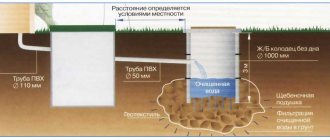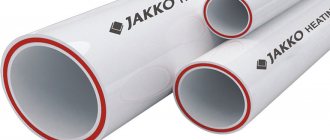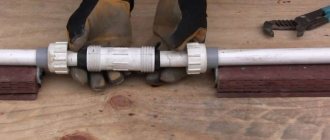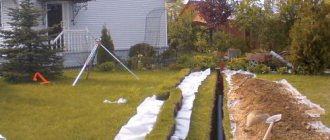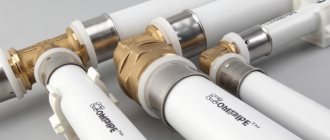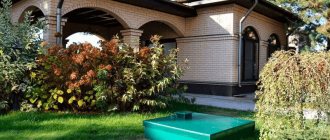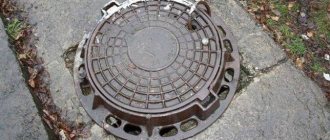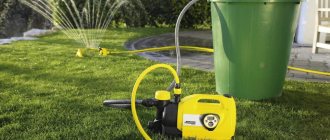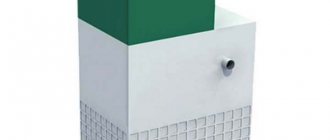The installation of a sewerage system and a well is a prerequisite in private and multi-storey buildings. Such structures are subject to certain requirements, so they must fully comply with sanitary and hygienic standards. In addition, when installing a well treatment system for a country house, any person expects that the structure will last for decades, serving faithfully.
Therefore, the optimal solution when performing such work would be to install a concrete ring. This product is made of strong and durable material that can last almost forever, provided that the ring is correctly selected and the installation is carried out in compliance with all requirements. Therefore, it makes sense to consider the features of concrete rings, understand the size range and installation methods.
What types of rings are there? Types and purpose
Well rings are round reinforced concrete structures used for arranging utility lines buried below ground level. Depending on the structure being constructed, the following types of rings are used:
- Sewage and water intake.
- Products for laying underground cable electrical networks.
- Collectors.
- Gas pipelines and water intakes.
In addition, there are the following varieties on the market:
- Rings with flat and locking ends.
- Repair.
- Additional ones.
- Supporting.
Regardless of the type and purpose, the products are made of heavy concrete, grade 200-500 , and reinforced.
Fittings for plastic pipes
PVC sewerage fittings
A fitting is the part of the pipeline needed to connect a pair of pipes at an angle, in the case of joining more than two pipes, etc.
The fittings also allow you to connect the local sewer system to the city main.
Where are fittings used? Most often they can be found during the installation of sewage systems in residential buildings, and these can be both residential buildings in the city and beyond, and in high-rise apartments. The fittings can be used in systems through which wastewater passes at a temperature of no more than 80° C, as well as for the removal of short-term wastewater at a temperature of 95° C. The drainage is intended not only for dirty water from a sink, toilet or shower stall, but also for certain chemical compositions, the coefficient of which, recognizable as pH, has a spectrum from 2 to 12.
Types of fittings
Fittings for external and internal sewerage
According to their type, fittings can be as follows:
- those that are used in systems installed inside the house;
- those used in systems outside the home.
The method of connecting fittings is also different and can be done using a rubber gasket in the form of a ring and, in rare cases, by gluing.
The O-ring is not used as a last resort.
Production technology
Rings for wells are made from hard concrete, which is poured into the formwork. It is necessary to clarify that the reinforcement is first made from steel wire with a diameter of 8-12 mm . Two vertical rods are installed at opposite ends of the structure, which act as lugs for lifting the ring.
The mold is compacted using vibration to prevent the formation of voids. The formwork is removed one day after pouring the concrete. After this, the finished products are stored in open areas. The ring's tempering strength ( 50% of the specified value ) is achieved in approximately 7 days . Full concrete strength is achieved after 28 days .
Types of fittings for the installation of internal sewer systems
Fittings are parts thanks to which docking units, turns, branches are mounted, and pipes of different diameters are connected into a single network. During wiring, the presence of all kinds of fittings allows you to create complex shapes of structures from straight components.
The shaped parts, as well as the pipes of the internal sewage system, are made of gray PVC. Currently, the following types of fittings are used in construction:
- double-socket coupling - a part that connects sections of pipes of equal diameter that do not have a socket in one line without bends;
- Slide-on repair coupling - a part for eliminating emergency situations and various damage to the pipeline (leaks, cracks, breakdowns). Convenient for repairs in a section of the system where it is necessary to remove part of the damaged line;
- inspection coupling – a connection element with three inputs, the central input (hole) is equipped with a screw cap. By opening the lid, you can clean clogged pipes. Placed in a place where there is convenient access;
- compensation pipe - a piece of pipe 17-25 cm long, on one side it has an elongated socket, on the other - a smooth part, which is attached to the pipeline with a connecting coupling. Designed to increase the length of pipes and replace damaged sections;
- an adapter between two pipes of different diameters, called a reduction - an eccentric coupling, where the bell part goes for the large diameter, and the coupling part for the small one;
- cast iron/plastic adapter - used to connect cast iron sewerage to plastic, has a bell-shaped inlet with a diameter suitable for a cast-iron pipe and a coupling;
- elbow or elbow – curved 15-90 degrees. a part with a wide selection of diameters for designing sewer pipe bends;
- tee - a Y or T-shaped fork used to connect one branch to the main pipeline. An additional entrance with a bell may have equal or smaller dimensions;
- cross - an element for connecting two bends to the main pipe in the same plane, and the diameters of the bends can be different from the diameter of the main riser;
- two-plane cross - a connecting point in which two branches are connected on the left or right side perpendicular to the main pipe;
- a cover for blocking the end of the pipeline or a plug blocks the movement of drains;
- vacuum valve (aerator) – prevents the release of dangerous sewer gases into the room through installed plumbing fixtures due to vacuum in the system, mounted at the top point of the riser;
- exhaust hood - an element of aeration of the riser in the form of a plug with holes, prevents the ingress of debris and precipitation;
- siphon - an element connecting the outlet and plumbing. Its curved shape creates a water seal that holds back waste odors;
- clamp – pipe mounting fastener.
The range of fittings is very wide, you can choose a part to solve any problem
The connection of PVC fittings to pipes can be glued, welded (soldered), threaded (drain with a small diameter, for example a sink) and using a rubber ring. Whatever type of connection is used, you need to remember that the joint is the most critical place in the installation of a sewer system. The operation of the entire system depends on the quality of the joining of fittings, so you should carefully consider this issue or contact a specialist.
The shaped parts for internal sewerage are equipped with a rubber sealing ring, which, when assembling the network, ensures a reliable, tight connection. However, there are recommendations to strengthen this type of connection with silicone sealant to prevent the rubber from drying out. The sockets without a rubber layer are connected using glue. When hardened, the structure of the glue becomes similar to PVC with the same characteristics as pipes.
Before joining the fittings, pipes and plumbing must be carefully secured to avoid disruption during the assembly process and possible leaks.
Advantages and disadvantages of reinforced concrete rings
It's no secret that any building material has its strengths and weaknesses. This feature also applies to finished products. Concrete rings seem ideal, but even they are not without some drawbacks.
The undeniable advantages of reinforced concrete rings include the following:
- High quality at an affordable price.
- Wide range of sizes.
- The ability to quickly install a water supply and sewerage system.
- High tightness: tight fit of the seams prevents groundwater from entering the structure.
- Long service life: reinforced concrete is neutral to any environment, so it can last at least 100 years .
- Structural rigidity: wells made of concrete rings can be installed even on unstable soil.
Obvious disadvantages include the following:
- Dimensions and weight: it is impossible to install a concrete ring without the use of construction equipment, which somewhat increases the cost of installation.
- Lack of mobility: it is very difficult to move such a well.
You can see that there are more positive features, which explains the steadily growing popularity of concrete rings.
Application area
The scope of application concerns the arrangement of structures characterized by high tightness. That is why reinforced concrete products are used to construct a septic tank. A septic tank is the same drainage pit, but with the ability to treat wastewater. A septic tank of two or three parts can be installed on one site.
The more well rings you use, the cleaner the water will be when it comes out. In the case of three rings, the septic tank can produce almost pure water at the outlet, which can be used to water the garden.
When using rings as a basis for a septic tank, they must be additionally sealed. To do this, the outer diameter of the hole in the ground is dug out larger, a septic tank is installed, and then the outside is coated with bitumen.
Using reinforced concrete rings for cesspools
Using well rings, today you can equip a pit for a well. This is a recess of up to 2 meters, where equipment can be installed in the future. By default, the well head is located on the base of such a pit. It is recommended to install well equipment in homes, since here it will be less exposed to moisture. This way the pressure switch can work longer without failure.
Reinforced concrete rings are also used for constructing wells. In this case, they can be with a base and a lid. This will keep the water used for drinking and irrigation clean. The diameter is not chosen to be the largest so that the water column meets the customer’s wishes.
Otherwise, reinforced concrete rings are used for the needs of sewer systems, for laying communications underground, and for constructing underground drainage holes. They are able to withstand significant external loads from the soil, and not collapse under the influence of moisture for a long time. By performing the necessary sealing of the joints, you can achieve 100% insulation, which is important when installing cables, pipes and other communication systems inside the rings.
Marking according to GOST. How to read symbols correctly
Each reinforced concrete ring has a marking that determines the scope of application of the product. The symbols correspond to GOST standards, it looks like this:
- KLK - products intended for the arrangement of drains and urban storm sewers.
- KVG - rings used for installation of gas pipelines and water wells.
- KO is a support ring that forms the foundation of the well.
- KS - wall models installed in limited spaces.
- KFK – drainage systems and collector networks.
In addition, the ring markings also contain numerical designations.
Decryption example:
KS-7-9 . This means a wall ring with a wall thickness of 70 and a height of 900 mm .
General information
Types of networks
A sewer network is a communication with different branches, which consists of different pipes and represents one whole.
This system is necessary for transporting wastewater from users to specialized containers in which water is processed and purified.
There are two types of sewer networks:
- Internal;
- Outdoor.
Pipes and treatment systems that are located on the street refer to the external type of sewer networks. And the pipes that are located inside houses are classified as internal.
In such communications, wastewater is transported both under pressure and by gravity.
Therefore, all sewerage pipelines are divided into:
- Non-pressure;
- Pressure.
Gravity pipelines of sewerage systems are installed at an angle to ensure the movement of wastewater to the final point. For the installation of free-flow sewerage, polyethylene pipes are used.
Pressure sewer networks operate according to this principle: the pump builds up pressure and, under its action, wastewater is discharged. For pressure pipelines, pipes of good strength are used, this is necessary so that they can cope with pressure.
Also, sewer systems, depending on the purpose, are divided into the following types:
- Storm sewers (discharging melt and rain water);
- Production;
- Economic and household.
- Storm drainage is needed to remove rain and melt water.
Household sewerage is divided into two types:
- Autonomous (local);
- Central (main).
The central type of sewer system removes sewage from houses in a city area or populated area, and an autonomous sewer system serves only one house (in isolated cases, several houses).
The method of installing external sewers is divided into:
- Separate;
- General alloy;
- Semi-separated.
External sewer networks
There are several types of sewer networks that are laid externally.
Trace. This design is installed from a point to a specialized tank. Tracing is also installed in an apartment building (observing all building rules and regulations). Pipes are laid only vertically. The distance from the outer wall of the building to the communications must be at least three meters. Trace installation is carried out only when there are connections to the central sewerage network.
External sewerage consists of pipes, wells and collectors.
Sewage network located on the street. This system consists of a complex system of wells and pipes. It is done on the streets of the city. Through street sewer networks, wastewater moves to the central sewerage system, and then to treatment systems.
Collectors. These devices are designed to collect sewage and redirect it if necessary. Sewage is redirected from collector to collector, which is located near the sewerage basin or on its territory. The work of the collector is to transport wastewater by gravity or under pressure.
Treatment buildings are the final destinations for sewage. These facilities concentrate and purify wastewater. After the water is purified, it is discharged into reservoirs and then used for economic purposes.
The laying of sewer networks takes place in different ways because it depends on specific cases.
Standard sizes of reinforced concrete rings
Concrete rings are available in a very diverse range of sizes. Standard product sizes look like this:
- Height: 10-100 cm .
- Wall thickness: 70-120 mm .
- Inner diameter: 70-200 cm .
- Specific gravity: 46-2,300 kg .
Thanks to these standard sizes, choosing rings for arranging an individual water supply system is not difficult.
| Name | Diameter D, mm | Diameter d, mm | Height h, mm | Thickness, mm | Concrete volume, cubic meters | Weight, tons |
| K-10-10 | 1160 | 1000 | 990 | 80 | 0.27 | 0.68 |
| K-10-5 | 1160 | 1000 | 490 | 80 | 0.14 | 0.35 |
| K-12-10 | 1410 | 1250 | 990 | 80 | 0.33 | 0.82 |
| K-12-5 | 1410 | 1250 | 490 | 80 | 0.17 | 0.42 |
| K-15-10 | 1680 | 1500 | 990 | 90 | 0.44 | 1.1 |
| K-15-5 | 1680 | 1500 | 490 | 90 | 0.22 | 0.55 |
| K-20-5 | 2200 | 2000 | 490 | 100 | 0.33 | 0.82 |
| K-7-1.5 | 840 | 700 | 145 | 70 | 0.024 | 0.06 |
| K-7-10 | 840 | 700 | 990 | 70 | 0.17 | 0.42 |
| K-7-5 | 840 | 700 | 495 | 70 | 0.084 | 0.21 |
| KS 7.6 | 840 | 700 | 590 | 70 | 0.3 | 0.25 |
| KS10.18a | 1160 | 1000 | 1790 | 80 | 0.46 | 1.15 |
| KS10.3 | 1160 | 1000 | 290 | 80 | 0.08 | 0.2 |
| KS10.6 | 1160 | 1000 | 590 | 80 | 0.16 | 0.4 |
| KS10.9 | 1160 | 1000 | 890 | 80 | 0.24 | 0.6 |
| KS10.9a | 1160 | 1000 | 890 | 80 | 0.22 | 0.55 |
| KS13.6 | 1410 | 1250 | 590 | 80 | 0.2 | 0.5 |
| KS13.9a | 1410 | 1250 | 890 | 80 | 0.28 | 0.7 |
| KS13.9b | 1410 | 1250 | 890 | 80 | 0.24 | 0.6 |
| KS15.18 | 1680 | 1500 | 1790 | 90 | 0.804 | 2.01 |
| KS15.18a | 1680 | 1500 | 1790 | 90 | 0.75 | 1.88 |
| KS15.18b | 1680 | 1500 | 1790 | 90 | 0.72 | 1.8 |
| KS15.6 | 1680 | 1500 | 590 | 90 | 0.265 | 0.66 |
| KS15.6b | 1680 | 1500 | 590 | 90 | 0.22 | 0.55 |
| KS15.9 | 1680 | 1500 | 890 | 90 | 0.4 | 1 |
| KS15.9a | 1680 | 1500 | 890 | 90 | 0.35 | 0.88 |
| KS15.9b | 1680 | 1500 | 890 | 90 | 0.32 | 0.8 |
| KS20.12a | 2200 | 2000 | 1190 | 100 | 0.67 | 1.68 |
| KS20.12b | 2200 | 2000 | 1190 | 100 | 0.64 | 1.6 |
| KS20.18b | 2200 | 2000 | 1790 | 100 | 1.02 | 2.55 |
| KS20.6 | 2200 | 2000 | 590 | 100 | 0.39 | 0.98 |
| KS20.6b | 2200 | 2000 | 590 | 100 | 0.3 | 0.75 |
| KS20.9 | 2200 | 2000 | 890 | 100 | 0.59 | 1.48 |
| KS20.9b | 2200 | 2000 | 890 | 100 | 0.44 | 1.10 |
| KS25.12a | 2700 | 2500 | 1190 | 100 | 0.87 | 2.18 |
| KS25.12b | 2700 | 2500 | 1190 | 100 | 0.76 | 1.90 |
| KS25.6 | 2700 | 2500 | 590 | 100 | 0.48 | 1.2 |
| KS7.3 | 840 | 700 | 290 | 70 | 0.05 | 0.13 |
| KS7.9 | 840 | 700 | 890 | 70 | 0.15 | 0.38 |
| KTs12.9 | 1410 | 1250 | 290 | 80 | 0.30 | 0.75 |
| KTs25.12 | 2700 | 2500 | 1190 | 100 | 0.97 | 2.42 |
| PK-7S | 870 | 650-670 | 360 | 100-110 | 0.036 | 0.09 |
What else is needed? Additional items
It should be noted that installing rings alone will not solve the problem of a high-quality water supply system. In order for the well to meet the requirements, the installation of additional elements will be required. This is not a mandatory condition, but compliance with this rule will help prevent contamination of the system with wastewater, increase its service life, and give the structure a complete look.
For this purpose:
- Bottom slabs provide a reliable foundation.
- Floor slabs - thanks to a narrow hole on top of such a slab, a ring of small diameter is installed, closed with a regular manhole cover.
- Additional rings are products of standard diameter, but smaller thickness. Such elements help raise the height of the well to the desired level.
The use of such products ensures maximum tightness of the well and prevents pipes from freezing in winter.
Covers for wells
| Name | Diameter Dн, mm | Diameter Din, mm | Thickness H, mm | Concrete volume, cubic meters | Weight, tons |
| 1PP 15 | 1680 | 700 | 150 | 0.333 | 0.69 |
| 1PP 20 | 2200 | 700 | 160 | 0.608 | 1.37 |
| 1PP 25 | 2700 | 700 | 180 | 1.031 | 2.45 |
| 1PP 25-2 | 2700 | 700 | 180 | 1.031 | 2.4 |
| 1PP 8 | 1000 | 580 | 170 | 0.134 | 0.33 |
| 1PP15-1 | 1680 | 700 | 150 | 0.27 | 0.68 |
| 1PP15-2 | 1680 | 700 | 150 | 0.27 | 0.68 |
| 1PP20-1 | 2200 | 700 | 160 | 0.51 | 1.38 |
| 1PP20-2 | 2200 | 700 | 160 | 0.51 | 1.38 |
| 2PP 15 | 1680 | 700 | 150 | 0.333 | 0.69 |
| 2PP 20 | 2200 | 1000 | 160 | 0.608 | 1.2 |
| 2PP 20-2 | 2200 | 1000 | 160 | 0.45 | 1.2 |
| 2PP 25 | 2700 | 700 | 180 | 1.031 | 2.4 |
| 2PP 25-2 | 2700 | 700 | 180 | 1.031 | 2.31 |
| 2PP 8 | 1000 | 800 | 170 | 0.134 | 0.33 |
| 2PP15-1 | 1680 | 700 | 150 | 0.27 | 0.68 |
| 2PP15-2 | 1680 | 700 | 150 | 0.27 | 0.68 |
| 2PP20-1 | 2200 | 1000 | 160 | 0.45 | 1.2 |
| 3PP 15 | 1680 | 1000 | 150 | 0.333 | 0.54 |
| 3PP 15-1 | 1680 | 1000 | 150 | 0.21 | 0.53 |
| 3PP 15-2 | 1680 | 1000 | 150 | 0.21 | 0.53 |
| 3PP 20 | 2200 | 700 | 160 | 0.608 | 1.34 |
| 4PP 20-2 | 2200 | 700 | 160 | 0.608 | 1.28 |
| KCP1.20N | 2200 | 700 | 160 | 0.51 | 1.28 |
| KCP1.25N | 2700 | 700 | 180 | 0.92 | 2.31 |
| KCP2.25 | 2700 | 700 | 180 | 0.96 | 2.40 |
| PVG-15 | 1720 | 700 | 140 | 0.27 | 0.68 |
| PVG-20 | 2240 | 700 | 160 | 0.57 | 1.43 |
| PVG-25 | 2740 | 700 | 180 | 0.99 | 2.48 |
| PVK-8 | 1000 | 400 | 170 | 0.06 | 0.15 |
| PK-10 | 1200 | 700 | 120 | 0.09 | 0.225 |
| PC-12 | 1450 | 700 | 140 | 0.18 | 0.45 |
| PK-15 | 1720 | 700 | 140 | 0.27 | 0.68 |
| PC-15-10 | 1720 | 1000 | 140 | 0.21 | 0.52 |
| PK-20 | 2240 | 700 | 160 | 0.54 | 1.35 |
| PK-20-10 | 2240 | 1000 | 160 | 0.5 | 1.25 |
| PK-25 | 2740 | 700 | 180 | 0.96 | 2.4 |
| PK-25-15 | 2740 | 1500 | 180 | 0.74 | 1.85 |
| PKB8 | 1000 | 400 | 170 | 0.06 | 0.15 |
| PKM8 | 1000 | 580 | 170 | 0.08 | 0.19 |
| PP 10 | 1160 | 700 | 150 | 0.159 | 0.25 |
| PP 13 | 1410 | 700 | 150 | 0.234 | 0.44 |
| PP10-1 | 1160 | 700 | 150 | 0.1 | 0.25 |
| PP10-2 | 1160 | 700 | 150 | 0.1 | 0.25 |
| PP13-1 | 1410 | 700 | 150 | 0.18 | 0.45 |
| PP13-2 | 1410 | 700 | 150 | 0.18 | 0.45 |
Bottom plates
| Name | Diameter D, mm | Thickness h, mm | Concrete volume, cubic meters | Weight, tons |
| Mon 7 | 840 | 100 | 0.12 | 0.09 |
| PN10 | 1500 | 100 | 0.18 | 0.45 |
| PN15 | 2000 | 120 | 0.38 | 0.95 |
| PN20 | 2500 | 120 | 0.59 | 1.48 |
| PN25 | 3000 | 140 | 0.98 | 2.45 |
Support rings
| Name | Diameter D, mm | Diameter d, mm | Thickness H, mm | Concrete volume, cubic meters | Weight, tons |
| K-1 | 840 | 700 | 180 | 0.053 | 0.13 |
| KO1 | 900 | 600 | 100 | 0.045 | 84 |
| KO4 | 840 | 580 | 40 | 0.02 | 40 |
| KO6 | 840 | 580 | 70 | 0.02 | 0.05 |
Rings with caps
| Name | Diameter D, mm | Height H, mm | Diameter d, mm | Thickness B, mm | Concrete volume, cubic meters | Weight, kg |
| PC 10 | 1160 | 890 | 1000 | 80 | 0.36 | 780 |
| PC 15 | 1680 | 890 | 1520 | 80 | 0.61 | 1400 |
Recommendations for selection
The shaped element for sewerage is selected according to the following criteria:
Material of manufacture. It is desirable that it completely matches the type of pipes used to lay the collector. Internal section of products. It must correspond to the diameter of the pipes: if the collector has a cross-section of 110 mm, the outlet for sewer pipes is taken with a diameter of 110 mm, no more and no less. Availability of rubber seals. They greatly facilitate the sewer installation process. Product compliance with GOST. As a rule, there is a corresponding marking on the outside of the product. Bend angle
It is important to correctly calculate the line configuration in order to avoid errors when arranging its direction. The presence of a flat, smooth inner surface of the product. Otherwise, in the future, wastewater with large inclusions will provoke the formation of growths on the walls of the collector.
Installation process
In order for the well to meet the established requirements, the installation of the structure must be carried out in accordance with all the rules. Here you need to follow the well-known procedure:
- Selecting a location
Water wells and drainage systems are not located close to residential buildings. The average distance from the house is about 5 meters . There should be no groundwater in the chosen location, otherwise you will have to incur additional costs for sealing. In addition, special equipment must be freely accessible to the installation site. - Pit
To dig a pit, it is better to hire equipment: the depth of the hole should be equal to the height of two rings. Digging such a pit by hand will be very problematic. A drainage cushion made of layers of sand and crushed stone, at least 50 cm .
- Rings
For the lower tier, a ring with a solid bottom is ideal; if the product is through, the bottom slab is laid first. The elements are installed on top of each other using a truck crane, the joint is covered with mortar. If the well is mounted on moving soil, the joint can be reinforced with metal staples.
After installing the rings, communications are brought to the well, the necessary connections are made, the foundation pit is filled, the rings are covered with a top slab, and sewer hatches are installed.
What are trays for?
The essence of the operation of drainage systems is the timely removal of precipitation and melt water accumulating on the road surface. For this purpose, the road surface is given a transverse and longitudinal slope, and storm drains are installed in the right places. Through these drainage pits, water enters a complex channel system consisting of drainage trays, stop blocks and other elements. The water diverted through these channels is discharged into acceptable locations, such as into the local river system.
If you neglect to organize high-quality drainage, sediment and melt water will accumulate on the road. And this is fraught with the destruction of road pavement and erosion of the roadbed, which in turn will lead to a rapid cessation of the functioning of the road.
